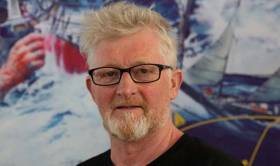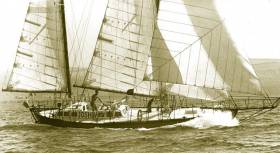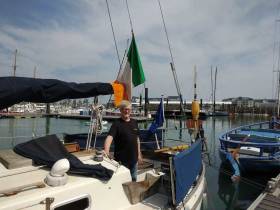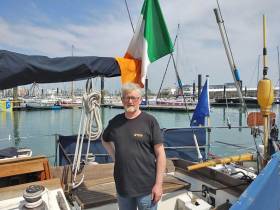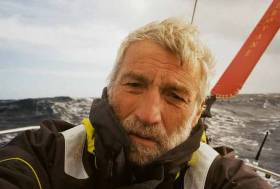Displaying items by tag: Golden Globe Race
On the 4th September, Limerick sailor Pat Lawless will begin the ‘Race of his Life’, sailing solo around the world in the Golden Globe Race 2022, non-stop and unassisted by technology other than a compass, sextant, the stars and the sun. And Killaloe Sailing Club are proud to have an association with newest club member Pat on his worldwide voyage, with the Club undertaking a successful fund-raiser for him last year.
As a supporting organisation, the club logo will be engraved onto the bulkhead of his boat. Pat is sailing in a 36ft Saltram Saga in an event no Irish person has managed to complete before now, though in the previous race in 2018, Gregor McGuckin of Malahide in a Biscay 36 managed to get as far as the Indian Ocean before being dismasted, while he was rewarded internationally with the prestigious Rod Stephens Seamanship Trophy of the Cruising Club of America for his heroic efforts - despite having only jury rig - to rescue another disabled entrant.
 Limerick sailor Pat Lawless
Limerick sailor Pat Lawless
It’s the longest, loneliest sporting event in the World - nine months at sea alone in a small boat. It entails stepping back to the Golden Age of solo sailing, with no modern technology, sailing the race in the spirit of Brendan the Navigator and Conor O’Brien of Foynes, the first skipper to take a small boat around the world via the three great southern capes. An heir to this tradition, Pat Lawless grew up around boats learning to sail on the River Shannon, building his first boat at the age of just 12. And he has already sailed over 10,000 miles solo, while he is also no stranger to dinghy sailing.
The Golden Globe Race 2022 starts on 4th September, 2022 from Les Sables d’Olonne, France.
The 1968 Golden Globe was the first-ever around the world yacht race. Since then, legends like the only finisher and winner Sir Robin Knox Johnston, and Bernard Moitessier have inspired many sailors and created new Around the world races. Philippe Jeantot conceived the first 1998 Vendee Globe with the Golden Globe was part of his idea.
In 2018 with partner Les Sables d’Olonne, the Golden Globe returned to life 50 years later. This incredible Adventure continues with a third edition starting from Les Sables d’Olonne on Sept 4th 2022. Again, Les Sables d’Olonne stands with McIntyre Adventure as a passionate partner building a bigger and even more exciting event.
The 2018 GGR was a repeat journey into the unknown. The world had changed, but the world had never seen anything like it. 18 sailors set sail not knowing what to expect. We all held our breath and an international GGR Family followed day by day with genuine enthusiasm. Yachts were lost, stories were told and sailors everywhere were inspired. Some of the best sailors on the planet had lined up at the start in Les Sables d’Olonne. So too did the dreamers, just as they did in 1968.
 Guido Cantini on the bow of his GGR 2022 Vancouver 34 "Hannah of Cowes"
Guido Cantini on the bow of his GGR 2022 Vancouver 34 "Hannah of Cowes"
Unlike the first edition, the GGR Notice of Race was considered by French Maritime Authorities as the best for any yacht race ever to sail from this country and the Security Arrangements appropriate for the challenge.
10 months after the start, Tapio Lehtinen the last of only five sailors to complete the journey, crossed the finish line creating history once again. Jean Luc Van Den Heede, one of the great sailors of our time, won the 2nd Golden Globe. He was 73yo. and has been a beautiful dreamer his entire life! Like all entrants, his voyage was filled with drama and courage in the face of real adversity. It was tough! Very tough. He was at sea for 212 days totally alone, the equivalent of three Vendee Globes. His final VDH journal has and continues to inspires a new generation of sailors, as did his previous five solo circumnavigations of the Globe.
The GGR is unique and has established once again the core principles of that first in 1968 edition. Open to sailors young and old it is affordable in 32-36ft strong, recycled, seaworthy yet simple yachts. There is No technology, No satellite comms or GPS, No autopilots and only cassette tapes for music. The GGR is the ONLY solo race around the world with Absolutely NO Outside assistance of any kind.
The GGR is NOT a flying 10-week sprint around the Globe. It is a gruelling demanding and daring marathon. You could fly to Mars quicker than completing the GGR! Entrants spend more time in the Southern Ocean than most current races take to circumnavigate. There are no SKYPE calls home to family for psychological support, or engineers for advice. The GGR is total isolation on a grand scale. It steps back to a simpler time, where the sailor relies entirely on themselves for their own destiny.
This challenge is not for everyone. It’s serious. Only the best will finish. Question? IS it the toughest Solo Non-stop race around the world? Who cares? We know it is seriously tough with no comparisons. Yet it is a beautiful and simple Challenge. It takes a special sailor to even consider it possible. Those that finish in 2023 will again make history!
Today 28 entrants from 11 Countries have signed for the next edition. The British want the Golden Globe back! They are sending 8 sailors to recover it. Australia sends 6 entrants. We are excited to welcome # Damien Guillou and PRB to the GGR in the last few days, leading the three French entrants who will attempt to retain the Golden Globe trophy. New Zealand sends # Graham Dalton brother of Americas Cup winner # Grant Dalton, who is sailing JL VDH 2018 R36 Matmut, # Tapio Lethinen from 2018 GGR sailing “Asteria” covered with Barnacles returns with a plan to win. # Captain Coconut, Mark Sinclair also from 2018 returns with unfinished business. Our only woman entrant # Kirsten Neuschafr from South Africa is a sailor with the experience to win and a yacht that could actually do it! Our youngest is 26 yo. American # Elliott Smith and Oldest at 79, the indomitable multiple solo circumnavigator # David Scott Cowper from the UK. Only Four SUHAILI Class entries are still available to sailors hoping to join the 2022 GGR.
 Organiser Don McIntyre first time meets French GGR2022 entrant Damien Guillou
Organiser Don McIntyre first time meets French GGR2022 entrant Damien Guillou
“As organisers we learnt a lot from the last edition of the GGR”. said Don McIntyre, GGR Founder and race Chairman. “There have been changes and one of the biggest is a new start date Two months later than 2018 placing the fleet more favourably in the Southern Ocean. Safety and security standards remain high and sailing qualifications have been increased. The best is overall media coverage will be substantially upgraded”.
- A new 2-hour time penalty for every litre of fuel consumed during the race will be added to finishing times. This encourages all entrants to focus on Solar, Wind and Water power generation. Our world first WASTE MANAGEMENT plan for all entrants in the 2018 GGR will remain.
- For the first time Expanded MEDIA ACCESS to GGR skippers With Entrants receiving two direct satellite phone interviews from any media outlet, every week while racing. The possibility of sending satellite photos from entrants to Race Control is being investigated. A third Video film drop for live interviews is also scheduled for Cape Town, South Africa before sailors’ head into the Southern Ocean and a fourth may be established after rounding Cape Horn.
- A planned comprehensive Media Production and Global TV distribution plan will send the GGR story to millions of families around the world.
On July the 1st 2018, crowds that gathered on the famous Les Sables river cheering our GGR sailors witnessed something special. But they could never have imagined what lay ahead. The Golden Globe is personal, even romantic and centred on the sailor. Nothing else matters. It is seriously a human story, not the boat, not technology and not the money that creates the winner and it’s all about the stories.
On Sept 4th next year once again, these special sailors will set out on an adventure unique to this planet. They are all volunteers in what is now recognised as the longest, loneliest, slowest race and most daring challenge for any individual in any sport.
Ireland's Pat Lawless from County Kerry is one of the entries for 2022 and you can read more on him here
Dalton Brothers Take on Golden Globe & America's Cup!
One sails in the fastest, most sophisticated and prestigious sailing challenge in the world, all over in just minutes! The other is attempting the longest, loneliest, most demanding and slowest race, for any individual in any sport on the planet. The Dalton family wants it all! With the America's Cup just days away and the third edition of the gruelling eight-month solo Golden Globe Race starting next year, the contrast is extreme.
Graham Dalton, the elder brother of New Zealand’s America’s Cup supremo Grant Dalton, has entered in the 2022 Golden Globe Race. The gritty 66-year old from Auckland has unfinished business - to sail solo around the world and win! Two previous attempts have ended in disappointment. In the 2003 Velux 5 Oceans, a four-stop solo circumnavigation he was dismasted close to Cape Horn and in 2007 he completed the same race but outside the time allowance.
 Golden Globe Race 2022 Chart
Golden Globe Race 2022 Chart
Grant Dalton, on the other hand, has sailed all the major international Ocean races and won, including the Whitbread Around the world Race and of course the America's Cup. His dreams happened. It does not get any bigger or better. His big brother has had his dream since childhood. Inspired as a schoolboy by Sir Francis Chichester’s solo one-stop circumnavigation in Gypsy Moth IV back in 1966/7, he recalls: “Many of my friend’s parents had yachts and their boys would talk about Chichester’s adventure in the playground saying ’That’s what I’m going to do - sail around the world’. I knew they wouldn’t, but I made a commitment - and every day since, this has been my goal.”
But entering the next GGR non-stop solo round the world race, starting from Les Sables d’Olonne, France on September 4, 2022, has not been straightforward. Having been dismasted, suffered broken rudders, and torn sails, 4 fractured ribs, and endured chronic food poisoning during previous attempts, Graham says: “This time, I waited until I said to myself that I wanted to do this again three days in a row before making the commitment. It has taken some time to resolve.”
The decision was made only after a lot of soul searching and self-analysis. Graham is a determined, tenacious character with great self-belief, - many of the attributes shared with his younger brother Grant. The big difference between the two is that while Grant is happy to court the media spotlight, Graham is not. “I’d rather not have any publicity. I don’t need it because I won’t have a sponsor. It’s just a distraction that I can do without” He says. If it were possible, I sense that he would prefer to just turn up at the start dressed like the anonymous Japanese masked wrestler The Great Sasuka and take on all challengers. He’s happiest with his own company and a project to focus on. The media bruha and contact with the outside world - even competitors - he would just as happily do without. The perfect mindset for a solo sailor you might say.
But third time around, Graham has been asking questions - of himself and to others. One of these is about mental preparedness. A good American friend who had spent 23 years as a US Navy Seal advised: ‘The brave don’t live for ever, but the cautious never live.’ He now has the inscription on his study wall at home, alongside the badly buckled titanium steering wheel from his last yacht smashed by a wave as a reminder of what can happen at sea. And the message? I wouldn’t be surprised if it doesn’t finish up on a bulkhead within his yacht to bolster his mindset when things go awry as they undoubtedly will at some point during this 30,000 mile battle against the elements.
Another mentor is Jean-Luc Van Den Heede, the 73-year old French sailor who led the 2018 Golden Globe Race from the Cape of Good Hope all the way back to the finish. Graham has bought Van Den Heede’s Rustler 36 Matmut which bettered Sir Robin Knox-Johnston’s winning time set in the first Sunday Times Golden Globe Race in 1968/9 by 100 days. He has not only bought the winning yacht but hopes to benefit from the great knowledge and experience gained by the 6-time solo circumnavigator Jean-Luc.
 Jean-Luc Van Den Heede and his yacht MATMUT surfing down Biscay waves towards the finish line off Les Sables d’Olonne. Photo Christophe Favreau/GGR/PPL
Jean-Luc Van Den Heede and his yacht MATMUT surfing down Biscay waves towards the finish line off Les Sables d’Olonne. Photo Christophe Favreau/GGR/PPL
If Coronavirus travel restrictions allow, Dalton plans to travel to France in May to complete the yacht’s fit-out and sailing trials before setting out into the Atlantic on a 2,000 mile qualification solo sail to sweep away any lingering doubts. “I’ve got some ideas on how to make Matmut even faster. I’ve no interest in simply sailing around the world again. It is the competitive aspect that really appeals. I’ve entered the GGR to win, and without distractions, I think I can.” He says.
His brother Grant is of the same mindset. He has taken on the greatest high-tech sailing challenge on earth and won. In the next few days he puts it all on the line once again. Dreams don't come any bigger! The family conversations must be quite interesting!
Killaloe Sailing Club to Give Zoom Fair Wind to Limerick Golden Globe Racer Pat Lawless
Bring your own cup of tea, biscuits, glass of something stronger…. plan to sit back, unwind and enjoy watching and listening to the adventurous Pat Lawless as he tells Killaloe Sailing Club and everyone else the story tonight (Wednesday) at 7.30 pm of his plans to undertake the Golden Globe Race in 2022 in a 36ft Saltram Saga.
A solo, non-stop round the world sailing race, unassisted by any technology other than a compass, sextant, the stars and sun; sailing in the spirit of Brendan the Navigator and Edward Conor Marshall O'Brien.
No Irish person has achieved this to date. It is the longest, loneliest sporting event in the World. Nine months at sea alone in a small boat.
Zoom link here
Ireland is among 22 entries for the 2022 edition of the Golden Globe Race that will be hosted again by the Vendée City of Les Sables d'Olonne it has been announced this week.
As Afloat previously reported back in April, Pat Lawless of Ballyferriter in County Kerry aims to finish what Conor McGuckin started in the 50th anniversary of the Golden Globe Race and become the first Irishman to do a non-stop, unassisted solo circumnavigation of the world.
Entries have been received by Austria (1), Australia (5), Canada (1), France (2), Ireland (1), Italy (1), New Zealand (1), Norway (1), UK (7) and USA (2), four of which remain confidential.
"Pat Lawless is a great guy and has a very competitive boat and at this stage, he looks like he certainly knows how to use it. He may make his late father very proud, so watch this space! Good luck Pat and let's hope the luck of the Irish holds a little better for 2022", the race founder, Don McIntyre told Afloat.
Following the success of the 2018 Golden Globe Race, the Vendée City of Les Sables d'Olonne and its 3-town Agglomeration have voted unanimously to host the next Golden Globe Race in 2022. At a meeting on July 5, the City’s leaders also took out options to repeat the event in 2026 and 2030. The next start is scheduled for Sept 4th 2022 preceded by a two week Race Village in the Vendée Globe Marina to celebrate the history of singlehanded sailing.
The Race will once again be run under the auspices of the Royal Nomuka Yacht Club in Tonga.
The Golden Globe Race: Re-enactments of Great Sailing Achievements & Should The Past Be Left in Peace?
For those of us who find historical re-enactments to be slightly spooky, following the twists and turns of the Golden Globe Golden Jubilee Race through the latter half of 2018 and into the early months of 2019 has been - for want of a more appropriate phrase - a mildly disturbing experience writes W M Nixon.
The ultimate nature of what the participants were undertaking was utterly genuine. And in many cases, they had to draw very deeply on their own resources, and on bottomless wells of sheer courage, which the rest of us could barely imagine. Yet the complex business of using a re-enactment of a great seafaring achievement from all of 50 years ago, in order to capture attention nowadays and provide contemporary entertainment through this ultimate seafaring challenge – well, it just felt a bit unsettling.
There was an air of the stadium-staged gladiatorial contest about it which seemed to be at variance with the straightforward reality of lone sailors battling against the most vicious moods of the great oceans of the world. There was a slight whiff of exploitation. Yet beyond the unease was the realisation yet again of the totally unique beauty of what Robin Knox Johnston achieved with his 32ft own-built ketch Suhaili in 1969.
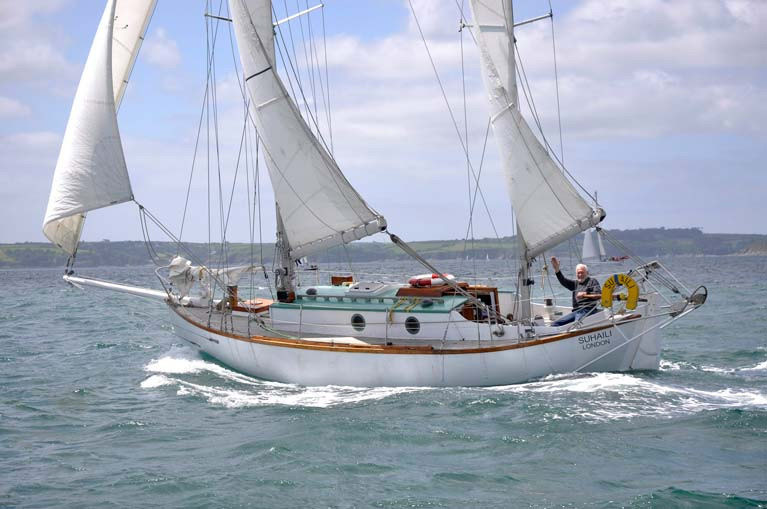 Robin Knox-Johnston sailing Suhaili in 2018
Robin Knox-Johnston sailing Suhaili in 2018
For sure, there had been Joshua Slocum in 1895 and Conor O’Brien in 1925 before him, pioneering the solo global circumnavigation and the circuit south of the great Capes.
But the voyage of the Suhaili has its own clearcut quality, reaching such a degree of perfection in being the first non-stop global circumnavigation that it seemed its greatest honour would lie in being left undisturbed, to be honoured in revered memory.
Of course, with the passage of time, there have since been other non-stop circuits, usually in larger and conspicuously more expensive craft which reach their apogee today in the IMOCA 60s and the Vendee Globe, such that non-stop global solo circuits are now almost entirely a matter of highly-competitive racing.
But even though Suhaili was in theory taking part in a race, it was a very disparate affair, and her skipper’s achievement became a standalone feat, its singular beauty enhanced by its recollection through the passing of the years. Yet the fact is that those of us who feel that something like this is best honoured simply by being remembered with respect are probably in a minority – and a small minority at that.
With the approach of the Golden Jubilee – fifty years since the first and only Golden Globe challenge - there were at least as many people who felt that a full-on re-enactment was a reasonable idea, and the organisers set about putting it in place.
By now we are all well aware of how the attempts to achieve retro authenticity by severe restrictions on navigational and communication aids put extra pressure on the participants. But better known is how the attempt to restrict boats to “something similar to Suhaili” went slightly astray. The requirement was for boats of “closed profile”, designed no later that 1988, of fibreglass construction with a minimum of 20 boats built from the mould, and with an overall hull length between 32ft and 36ft.
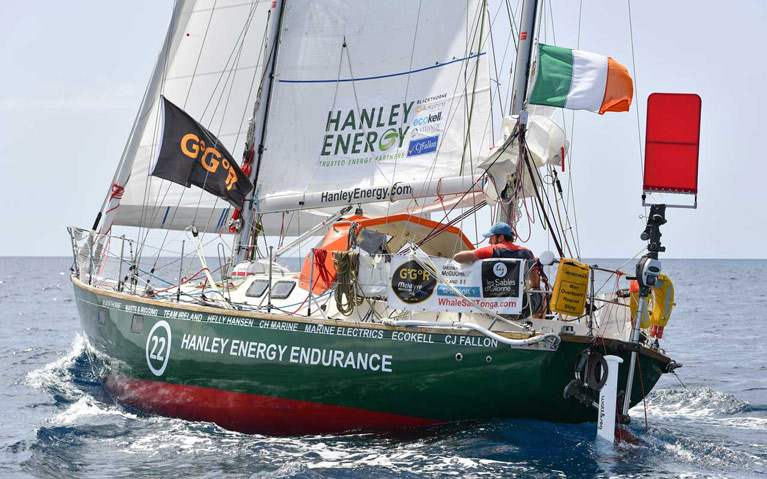 Gregor McGuckin’s Biscay 36 at the start of the Golden Globe Golden Jubilee, 1st July 2018. Professional sailor/adventurers such as McGuckin saw the race as an affordable opportunity to move into a higher level of competition and recognition
Gregor McGuckin’s Biscay 36 at the start of the Golden Globe Golden Jubilee, 1st July 2018. Professional sailor/adventurers such as McGuckin saw the race as an affordable opportunity to move into a higher level of competition and recognition
Initially, people thought of boats very broadly similar in type to Suhaili, with ketch rig. One who went down this route was our own Gregor McGuckin, a hugely experienced sailor with many Atlantic delivery crossings in his CV. He went for a Biscay 36 ketch designed in 1974 by Alan French, and put heart and soul into her preparation, as he saw the Golden Jubilee Golden Globe as offering a rare and affordable chance to step up to a higher level of international sailing.
Yet even at the most basic level of preparation, it was an expensive business, even if cheap by comparison with an IMOCA 60 campaign. For all entrants, the search for sponsorship was part of the process, though some were better prepared than others. In his early 70s, the successful veteran French sailing star Jean-Luc van den Heede saw the Golden Globe Golden Jubilee as an opportunity for a swansong performance. With his proven track record, he soon had secured sponsorship from insurance company Matmut, and with first place in mind and resources in place, he was able to act on research which showed that that boat which best filled the bill of taking line honours while complying with the regulations was the Rustler 36, a Holman & Pye sloop designed in 1980.
With a transom stern and a large sloop rig, the inherently fast Rustler 36 may look old-fashioned compared to modern craft. But she is light years away from William Atkin’s 1932 design from which Suhaili had been built, and when the fleet came to the line off Les Sables-d’Olonne on July 1st, Rustler 36s made up the largest group in the fleet, and soon were making much of the running.
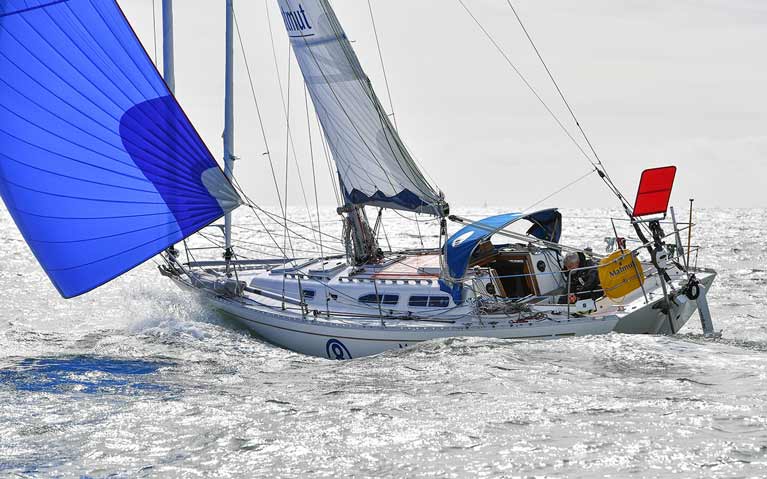 Jean-Luc van den Heede’s Rustler 36 Matmut, winner of the 2018-2019 Golden Jubilee Golden Globe
Jean-Luc van den Heede’s Rustler 36 Matmut, winner of the 2018-2019 Golden Jubilee Golden Globe
Yet neither they nor any other boats racing could remotely match the pace being set by Jean-Luc van den Heede in Matmut, and by the time he was passing Australia, he was well over a thousand miles in the lead, making it all seem like a walk in the park. Admittedly he experienced serious rig problems later in the race, but his overall win was richly deserved.
However, boats further down the fleet experienced insuperably rough weather in the Southern Indian Ocean. Gregor McGuckin and Abilash Tomy were within ninety miles of each, and both were rolled in a 90-knots-plus superstorm which left them dismasted.
In all, five boats out of the 17 starters were dismasted through a variety of rolling experiences in the Southern Ocean. This is an outcome which has led Robin Knox-Johnston into further researches whose conclusions were published on Monday of this week, and he quotes a US Coastguard report which indicates that being rolled or pitch-poled is a function of breaking wave height relative to boat length. This section of the report reads in full:
“The Southern Ocean is the only expanse of ocean that goes all the way around the world with no land in the way The result is that the depressions, which drive the winds and therefore the waves, have nothing to stop their development which leads to the creation of very large waves.
Recent research has shown that it is possible for rogue waves as large as 27+ metres to develop in this ocean. A rogue wave is defined as a wave that is twice the significant wave height, usually steeper and frequently reported as a wall of water. The force of these waves can be extreme. A 12-metre wave has a breaking pressure of about 6 metric tons per square metre, whereas a rogue can produce a pressure of up to 100 metric tons per square metre.
A very interesting United States Coastguard (USCG) study concludes that storm waves are generally not regular or stable, and individual waves do not hold their shape for very long. It indicates that the white water height of a breaking wave will have to be at least half the LOA of the boat for the boat to be rolled. This means that even a comparatively small 6 metre high breaking wave could roll the average boat of 36 feet length.
Thus the larger the boat the less susceptible it is to being rolled. Also, the larger modern boats like Open 60 class yachts are light with large sail areas and can usually outpace a wave which a heavier, smaller yacht cannot do.
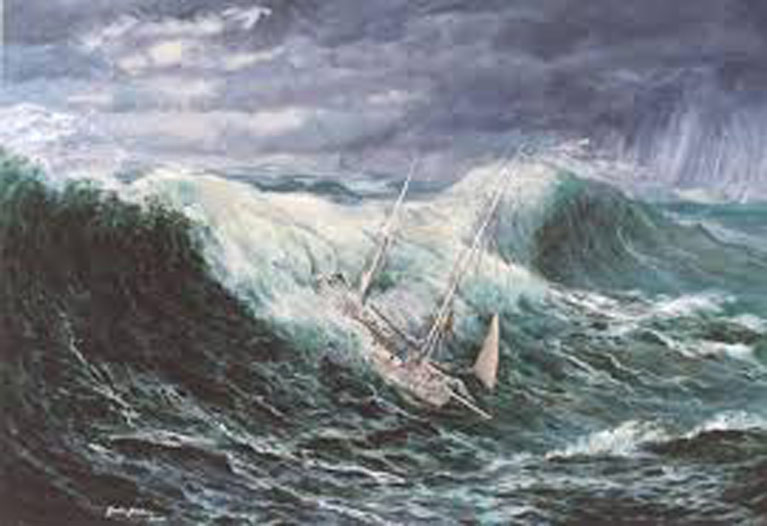 An artist’s impression of Suhaili in storm conditions in the Southern Ocean. From the painting by Gordon Frickers
An artist’s impression of Suhaili in storm conditions in the Southern Ocean. From the painting by Gordon Frickers
The USCG conclusion is that the danger does not come from a normal wave, but from a breaking wave regardless of the measures being taken to try and restrain the boat. That is not totally supported by some of the evidence from the experience here, although there is agreement on the danger of the breaking wave. The USCG report also suggests that a small boat in a non-breaking sea moves more or less with the surface water so will not be struck by the mass of moving water and therefore will be less likely to be capsized. So lying a-hull may work up to the point where the waves start to break. However, the water in a breaking wave at its crest moves much faster and can strike a boat at a speed of as much as 20 knots. This is confirmed by the experience of most reports of knockdowns in this race where the sound of the approaching breaking wave was heard before it struck.
The famous 26-metre rogue wave that struck the Draupner Oilfield Platform in the North Sea on 1st January 1995 has been replicated in the laboratory by Oxford and Edinburgh Universities. The evidence from these tests indicate that when waves are crossing each other at an angle of 120 degrees they could create the occasional giant wave. The conditions for this type of wave occur in the Southern Ocean.
A recent paper published jointly by the National Oceanography Centre and University of Southampton has concluded that Global significant wave heights have increased over the past 30 years, but occur less often.”
With such experiences being reported at mid-race and then conclusions like this being drawn in the post-race analysis, you might have thought that the organisers would have long since been reflecting that enough is enough - a commemoration every fifty years would more than adequate to be going along with. But not a bit of it. On the contrary, the Golden Jubilee Golden Globe Race wasn’t long underway before it became clear that another similar race was planned for four years time in 2022, and a list of interested sailors was already taking shape.
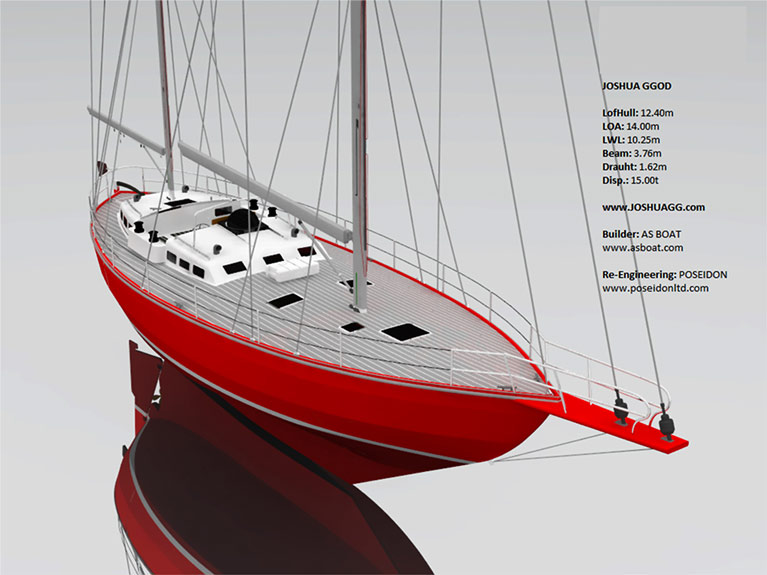 The new Joshua One-Design – ten will race in the 2022 Golden Globe
The new Joshua One-Design – ten will race in the 2022 Golden Globe
Not only that, but since August 2017 organiser Don McIntyre had been promoting the concept of a One Design Class within the 2022 race. It was not to be a One Design based on Suhaili - as you might have expected - but one based on Joshua, with which Bernard Moitessier had been fourth to start, more than two months after Robin Knox Johnston, in the original Golden Globe in 1968.
With this week’s wrap-up of the 2018 race being published, it was again stated that the 2022 fleet will be in two sections. There’ll be the mixed division for which Pat Lawless of Dingle has already put his name down with his Alan Pape–designed Saltram Saga 36.
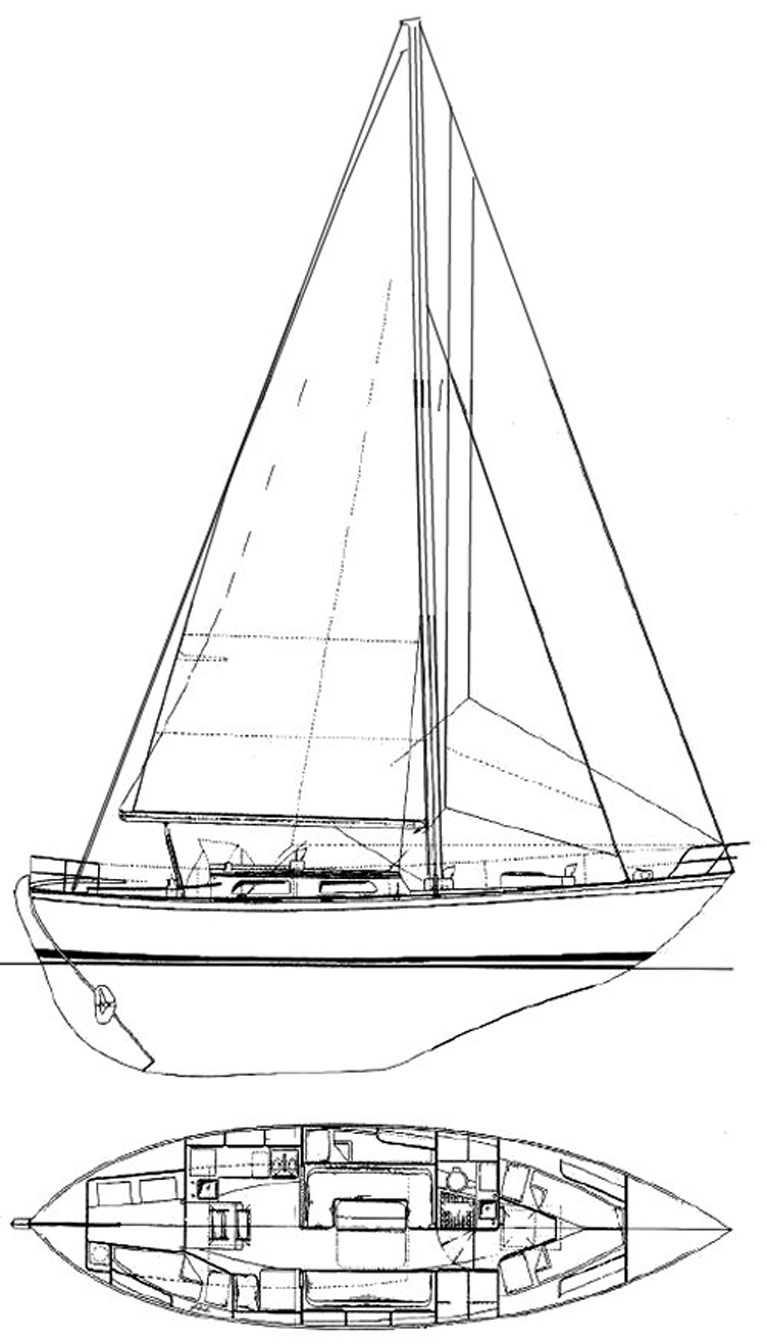 The Alan Pape-designed Saltram Saga 36 – Pat Lawless of Dingle has entered one for the 2022 Race
The Alan Pape-designed Saltram Saga 36 – Pat Lawless of Dingle has entered one for the 2022 Race
But there’ll also be this new strictly One Design Class of ten steel-built boats, constructed in Turkey and based on Moitessier’s 39ft Joshua, which was fourth away in 1968’s race and was a potential contender, but her skipper slipped into a very philosophical frame of mind and retired into the Pacific islands.
It was a French way of looking at seafaring competition which is very much at variance with their full-on competitions today, such as the Vendee Globe and the Figaro. Yet some top modern French sailors have some of the Moitessier philosophy in their make-up. After his impressive win in November 2017’s Mini Transat, 20-year-old Erwan le Draoulec admitted that he hadn’t really enjoyed the actual sailing, triumphant as it had been. He said that he felt he was abusing the Atlantic in sailing across it just as fast as humanly possible for 6.5 metre boat, and that at some time in the future, he would look forward to sailing across the ocean in a more gentle and contemplative style.
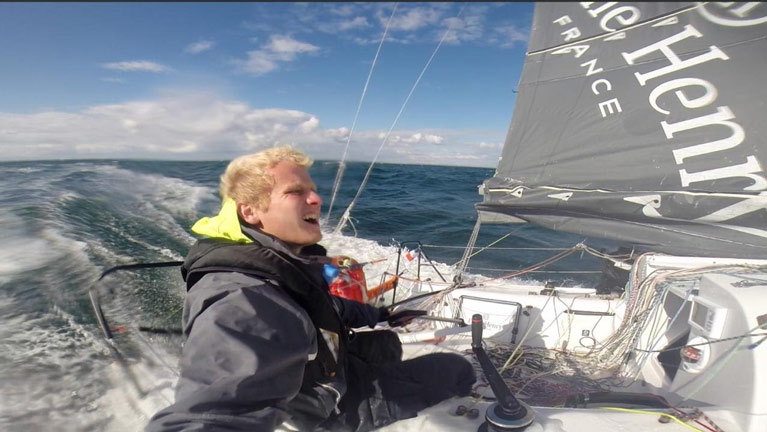 Erwan le Draoulec (21). The youthful winner of the Minitransat in November 2017 crossed the ocean so quickly he reckoned it was an abuse of the Atlantic
Erwan le Draoulec (21). The youthful winner of the Minitransat in November 2017 crossed the ocean so quickly he reckoned it was an abuse of the Atlantic
In the end, Bernard Moitessier (1925-1994) also came to a fresh view of what he was doing, but his change of heart came in mid-race. Alone on the ocean and in the lead, he found he was rejecting what he saw as the commercialisation of long distance sailing, and pulled out of the race to voyage among the Pacific islands. Yet it seems that in 2022, a certain level of commercialisation will revive memories of what he did. Like it or not, there seems to be a growing demand for re-enactments.
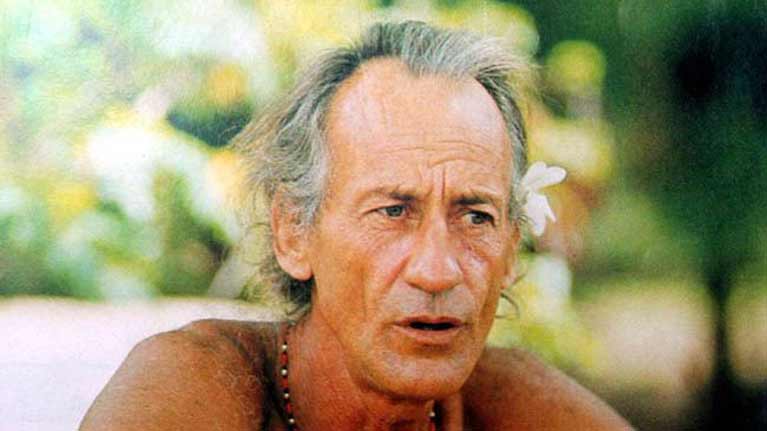 The sailor-philosopher. Bernard Moitessier (1925-1994) in thoughtful mood in his beloved Pacific islands
The sailor-philosopher. Bernard Moitessier (1925-1994) in thoughtful mood in his beloved Pacific islands
29/4/19: 7 pm: This article has been updated in light of Barry Pickthall's comments (below) - our thanks to him.
20 sailors from 10 countries have signed up to compete in the next Golden Globe Race slated to start on 4th September 2022, and many more have expressed an interest to compete. Among the line up as Afloat reported earlier is Pat Lawless in his Saga 36 from Limerick.
The 2022 GGR entrants to date are,
1 John Clarke (47) GBR - Nicholson 32 MKX
2 Ian Herbert Jones (49) GBR - Tradewind 35
3 Guy Waites (52) GBR
4 Ertan Beskardes (57) GBR - Rustler 36
5 Simon Curwen (60) GBR - Biscay 36
6 Robin Davie (67) GBR - Rustler 36
7 Confidenial GBR
8 Arnaud Gaist (47) FRA Barbican 33 MKII (long keel version)
9 Confidential FRA
10 Guy deBoer (63) USA
11 Doug Dean JOHNSON (53) USA - Rustler 36
12 Matthew Wright (49) AUS
13 Michael Date (57) AUS Aries 32
14 Confidenial AUS
15 Michael Guggenberger (41) AUT - Endurance 35
16 Gaurav Shinde (32) CAN
17 Pat Lawless (62) IRE Saga 36
18 Guido Cantini (50) ITA Vancouver 34
19 Confidenial NZL - Rustler 36
20 Confidenial NOR
Total: 10 Country, 7 British, 3 Australian, 2 France, 2 American, 1 Austria, 1 Canada, 1 Irish, 1 Italy, 1 New Zealand, 1 Norway.
12 with Boats already."
Sailors Salute Sir Robin Knox Johnston on 50 Year Anniversary of Golden Globe Victory
Britain’s leading sailors are paying tribute to Sir Robin Knox-Johnston today on the 50th anniversary of the date he made history as the first person to ever sail solo, non-stop around the world, 22 April 1969.
“To me, Sir Robin is an iconic figure and one of the greatest sailors to ever set foot in a boat.” Said Sir Ben Ainslie, Britain’s most decorated Olympic sailor, during filming for a documentary about the achievement, which took place in the same year of the first moon landing.
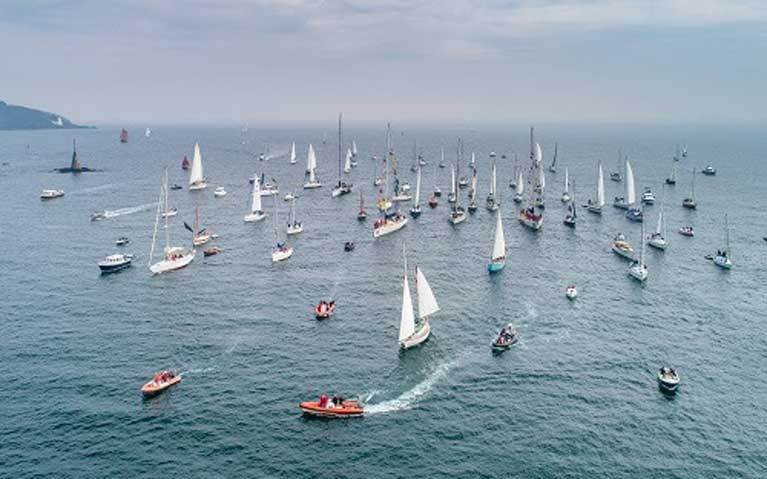 A truly impressive flotilla of vessels, including Royal Navy warship HMS Mersey, and over one hundred supporting yachts of all shapes and sizes, joined Sir Robin, and Suhaili in Falmouth Harbour to recreate the historic moment he returned home 50 years ago to scenes of national jubilation and changed the future of ocean racing forever
A truly impressive flotilla of vessels, including Royal Navy warship HMS Mersey, and over one hundred supporting yachts of all shapes and sizes, joined Sir Robin, and Suhaili in Falmouth Harbour to recreate the historic moment he returned home 50 years ago to scenes of national jubilation and changed the future of ocean racing forever
Sir Ben added: “The Golden Globe and Sir Robin Knox Johnston’s amazing triumph against the rest of the world, winning for Britain, was an amazing feat of seamanship and something that will never be forgotten.”
Crowds of supporters and a flotilla of vessels, including a Royal Navy warship, are expected to join Sir Robin and his 32-ft yacht from that voyage, Suhaili, in Falmouth Harbour today to recreate 50 years to the exact time, 1525, when he crossed the finish line of The Sunday Times Golden Globe Race and returned home to scenes of national jubilation.
Leading round the world yachtswoman Dee Caffari commented: “We often talk about the achievement of being the first man on the moon, and I think you can make a very similar comparison to Sir Robin for sailing around the world. He created that first non-stop sail that nobody thought was possible. It hadn’t been done until he completed it and he laid that pathway for all of us to follow.”
Inspired by Sir Francis Chichester, who had sailed around the world but had stopped in Australia, there was one achievement left in Robin’s mind; to be first to go solo, non-stop. He faced huge challenges in his quest to complete the unknown. Not only during the journey itself but also from sceptics. Could it actually be done? Would the boat hold up? Wouldn’t you go mad? How long would it take? Was Robin the man to achieve this feat?
A real-life story of the underdog, he received no sponsorship other than 120 cans of Tennants beer and a £5 Cadbury voucher. When he set sail from Falmouth on 14 June,1968, aged 29, he had jaundice but hid it as he feared he would have been stopped from going. Before the days of GPS satellite technology, he had only the same navigational tools as Captain Cook; the stars and a sextant. He had to fix a leak in the side of his yacht in shark infested waters, and not too far into his journey, he lost his freshwater tanks when his boat was knocked down by a wave, leaving him having to catch rainwater in his sails to survive.
Later, Robin lost all contact after his radio broke, and was presumed lost at sea for over four months before being reported alive by a British tanker just weeks from the finish line. He was also crippled with stomach pain in the latter stages and years later found out his appendix had likely burst, but still he carried on, dedicated to his mission. He also famously never officially entered the race, but the Sunday Times built the entry rules around his plans.
Of the nine people who set out in quest of becoming the first to circumnavigate solo, non-stop, the sailing equivalent of climbing Mount Everest, Sir Robin was the only one to complete the journey.
Comparing the experiences Sir Robin had fifty years ago compared to his own, British solo yachtsman
British solo yachtsman Alex Thomson, the youngest Skipper to ever win the Clipper Race, in 1996, said: “People ask what it is like now compared to when Robin did it in 1968-69. And for me there’s no relation. For one, I need to have reasonably constant communication with my team, with my family. I need to have that feeling that I have some control over the abilities where I'll talk to people, whereas back then Robin didn't have that.
He added: “The thought of doing more than 300 days, that's a different level, that's a completely different scale, so I can't see that what it is now is as hard as it was then. Perhaps the speed makes it more difficult, you know the stress of the speed being able to do 40 knots and instead of perhaps six or seven as a top speed, but still I would never choose to do what Robin did.”
In 1994, Robin set a record for the fastest circumnavigation with Sir Peter Blake in 1994, for which they were awarded the Trophée Jules Verne, was Knighted by the Queen in 1995 in recognition of his service to sailing, has been named Yachtsman of the Year an unprecedented four times, and was an inaugural entry into the International Sailing Federation (ISAF) Hall of Fame. In 2006, aged 67, he also set a new record for being the oldest yachtsman to sail solo around the world, in the Velux 5 Oceans Race.
Sir Robin also established the Clipper Round the World Yacht Race. The only event on the planet which trains amateurs to become ocean racing sailors, over 5,000 people internationally have taken part in the biennially held Clipper Race, which Sir Robin which considers to be one of his greatest legacy in sailing.
Various public celebrations took place over the weekend in Falmouth, including the unveiling of a brass footprint cast in Falmouth Haven marina to mark Sir Robin’s last steps as he departed on 15 June, 1968, and his first steps back on land 312 days later. An exhibition of recently unearthed images from his journey are also on display until 1 September at the National Maritime Museum Cornwall.
Son Of Circumnavigator Pat Lawless Aims For First Irish Non-Stop Voyage In 2022 Golden Globe Race
As the awards day for the 2018 Golden Globe Race is taking place today (Monday 22 April) in Les Sables, applications for invites to join the next Golden Globe Race in 2022 are now open — and one of those hopeful to join the global solo voyagers is Irish fisherman Pat Lawless.
Born in bred in Limerick on the banks of the River Shannon, Pat comes from a solo offshore sailing pedigree as his late father, also named Pat, completed his own circumnavigation of the world (in separate stages) in 1996 at the age of 70 — and since had a river festival named in his honour.
Pat Junior now lives in Ballyferriter, Co Kerry, the most westerly village in Europe, with his wife and two of his four children, and makes furniture for a living.
However, over the last six decades Pat has amassed around 150,000km on the water between sailing and fishing.
Now he aims to finish what Conor McGuckin started in the 50th anniversary of the Golden Globe Race and become the first Irishman to do a non-stop, unassisted solo circumnavigation of the world.
As Pat’s nephew Patrick Stritch explains to Afloat.ie, the boat he’s selected for the task is a Saltram Saga 36.
“Alan Papa designed her as a development of the Colin Archer ‘Redmingskoite’ sailing lifeboat hull, from which for many years have been regarded as being amongst the most sea-worthy around and even substantially faster than the original,” says Patrick.
“They are a mighty fine boat for the Southern Ocean, able to hold on to working sail in strong winds, without healing more than 20 degrees.”
Pat will have the next three years to get to know every aspect of his boat like the back of his hand before the next Golden Globe Race sets off from France on 21 August 2022.
This date commemorates the anniversary of Bernard Moitessier setting off in the original Sunday Times Golden Globe in 1968, and a new one-design class based on his famous yacht Joshua has been added for the next edition.
Sleeping is a Problem for Golden Globe Race Winner
After finishing the non-stop round the world Golden Globe Race in France last week, both Jean-Luc Van Den Heede and Mark Slats are struggling with the transition between their solo sailing world and reality ashore. Jean-Luc was comparing notes with Sir Robin Knox-Johnston, winner of the first Golden Globe Race in 1968/9, for both struggled to walk any distance after stepping ashore, though Jean-Luc (73) seemingly had little problem performing on stage with his rock band well into the early hours, while celebrating his win at a party held in his honour on the day he finished!
"difficult to stay asleep for more than 90 minutes"
Sleep has also been a problem. Slats is finding it difficult to stay asleep for more than 90 minutes without getting the urge to get up and check the sails. Jean-Luc, who lives in Les Sables d’Olonne, says that the only way he can overcome this is to go back to the boat where he sleeps soundly.
Rubbish Onboard
As part of their efforts to help save the planet, both skippers saved all their rubbish onboard. Today, this was weighed and compared with the food and other disposables taken onboard at the start. Jean-Luc brought ashore 14 bags weighing 93kg and Mark had 15 bags weighing 113kg


























